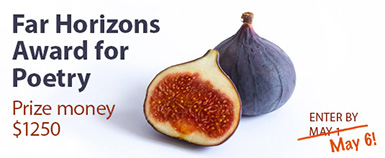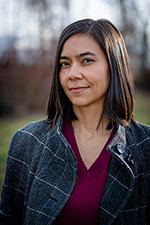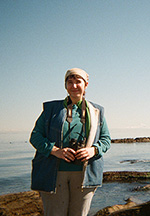|
|
Deadline extended to May 6!

Take the weekend to polish your poems. If you haven't yet published a book of poetry, our Far Horizons Award is for you.
This year's judge:
Patrick Grace
Entry fee (includes a one-year print subscription):
CAD $25 for each entry from Canada
CAD $35 for each entry from elsewhere
CAD $15 for each additional entry, no limit
Head over to our contest guidelines page to learn more.
Corinna Chong, issue #226 fiction contributor
 Past contributor Kathy Mak talks with the spring issue #226 contributor about emphasis on imagery, the private vs. public self, and letting the story guide character development. Past contributor Kathy Mak talks with the spring issue #226 contributor about emphasis on imagery, the private vs. public self, and letting the story guide character development.
KM: Ivy explains the masks are about a “performance of self”: “like the disconnect between the projected self and the real self. [Like] laying claim to a racialized identity in a way that feels kind of fake.” This resonated with me because there are many selves we project, depending on where we are and how we’re feeling. It made me think about the self that attends poetry readings and literary events, and how it’s different from the self that writes under the glow of the kitchen lights. As someone in diaspora, I feel I can never wholly connect with my Chinese heritage and Canadian culture. Do you have a similar disconnect between the projected self and real self? What were you trying to achieve when exploring this theme?
CC:
I suspect this rings true for all of us to some degree; the self we project to others is necessarily different from the self we harbour inside. I certainly feel this as a biracial person who was born and raised in Canada with little connection to my Chinese heritage. And like you, I also feel this as a writer; like many writers, I am an introvert and not at all a natural performer, so I definitely struggle with the disconnect between the private self and the public self. With this story, I wanted to play with the various layers of self by using Ivy’s masks as a metaphor for the artificial persona she is trying to cultivate. Ironically, while she claims to be blatantly, self-consciously illuminating this through her art, the masks are a cover for the inner conflict that she doesn’t yet know how to acknowledge. She focuses on her own suffering, seeing herself as a victim throughout the story, while being willfully callous and even blind to the very real struggles of the people around her, namely Javi and Cedar.
In addition, I think the idea that the projected persona of the artist differs from the “real” person that is the artist’s private self is also at play in the story. Ivy is desperate to be seen as a serious, vital, and edgy artist, to the point where she loses all perspective and allows the idea of the masks to spiral into disaster. By the end of the story, she realizes that the concept wasn’t actually an authentic one, nor were her perceptions of her relationships, which were being filtered through this lens. Ultimately, the “punctum,” or the quality that elicits an earnest and authentic emotional response, is missing, in both her art and her relationships.
Read the rest of Corinna Chong's interview & an excerpt.
Meghan Reyda-Molnar, issue #226 poetry contributor
 Past contributor Camille Lendor talks with the spring issue #226 contributor about the deconstruction of meaning, leaving room for nihilism, and how both oceanography and poetry are preoccupied with interconnection. Past contributor Camille Lendor talks with the spring issue #226 contributor about the deconstruction of meaning, leaving room for nihilism, and how both oceanography and poetry are preoccupied with interconnection.
CL: Some writers have the first few lines come to them in their head, while others have a specific ending in mind, and others have no idea what they’ll end up writing but come up with something anyway. When you write, what is your approach to the page, and does it change with each poem or stay largely the same?
MRM:
I think that the approach to poetry which grants me poems that I like and can see myself working on further is always sort of the same, even though I have been trying to alter my writing practice a bit lately. I have always been a poet who writes only when they feel in the current of something, which means poems come sporadically for me, rather than with any sort of consistency. Recently, I took a class on poetry (Poetry 1 with Rob Taylor at SFU) which forced me to write poems weekly and I found that a challenge, though I really do like this idea of experimenting/ practicing language on a regular basis, so that when inspiration strikes, the knives are already sharpened, there’s maybe less fumbling around and being scared about the thing being good. I never have a specific ending in mind, maybe I have a few lines to start at, or often it’s just a few words that are ringing. You feel that something is in there, and you have to tug carefully, like peeling a potato or an orange—trying to uncover what’s within while also trying to keep the spiral of the skin unbroken. And when you get to the end, you know it.
Read the rest of Meghan Reyda-Molnar's interview & a full poem.
Bill Gaston, issue #226 fiction contributor
 Past contributor Carlee Bouillon talks with the spring issue #226 contributor about meeting people who seed ideas, cultural idiosyncrasies, and how a relationship in a story can become a character. Past contributor Carlee Bouillon talks with the spring issue #226 contributor about meeting people who seed ideas, cultural idiosyncrasies, and how a relationship in a story can become a character.
CB: Literature loves relationships between mothers and daughters, fathers and sons, romantic partners, and women of all ages. But this story explores a less-investigated relationship in literature: a platonic friendship between two middle-aged men. What prompted you to begin thinking about the dynamic between these two men, and write their story? Which one of these characters came to you first?
BG:
Like most writers I know, I’m challenged by and enjoy exploring relationships between two awkward men, not just because the relationship itself becomes a kind of third character but because this character is endlessly odd, and complex. Relationships make men act up, hide, lie, dress carefully, drink or eat too much. Maybe I like exploring male relationships simply because men are often bad at them, so much so that when they get to a certain age they just stop trying. But relationships happen to them anyway, even to such as Jack and Dale, who are both loners by nature. As to which character came to me first, I have to confess that this story is the last one in a collection of linked stories, and the first story is all about Jack. So Jack has been lurking throughout the collection and it’s almost like he’s been biding his time before he launches himself at Dale. Jack has just accidentally killed a bird and his morals are such that now he needs to honour it by eating it, but to do that he needs to find and befriend someone who has a kitchen. Their relationship grows from there.
Read the rest of Bill Gaston's interview & an excerpt.
|
|
|
|
|
|
|
|
|
|
|
|